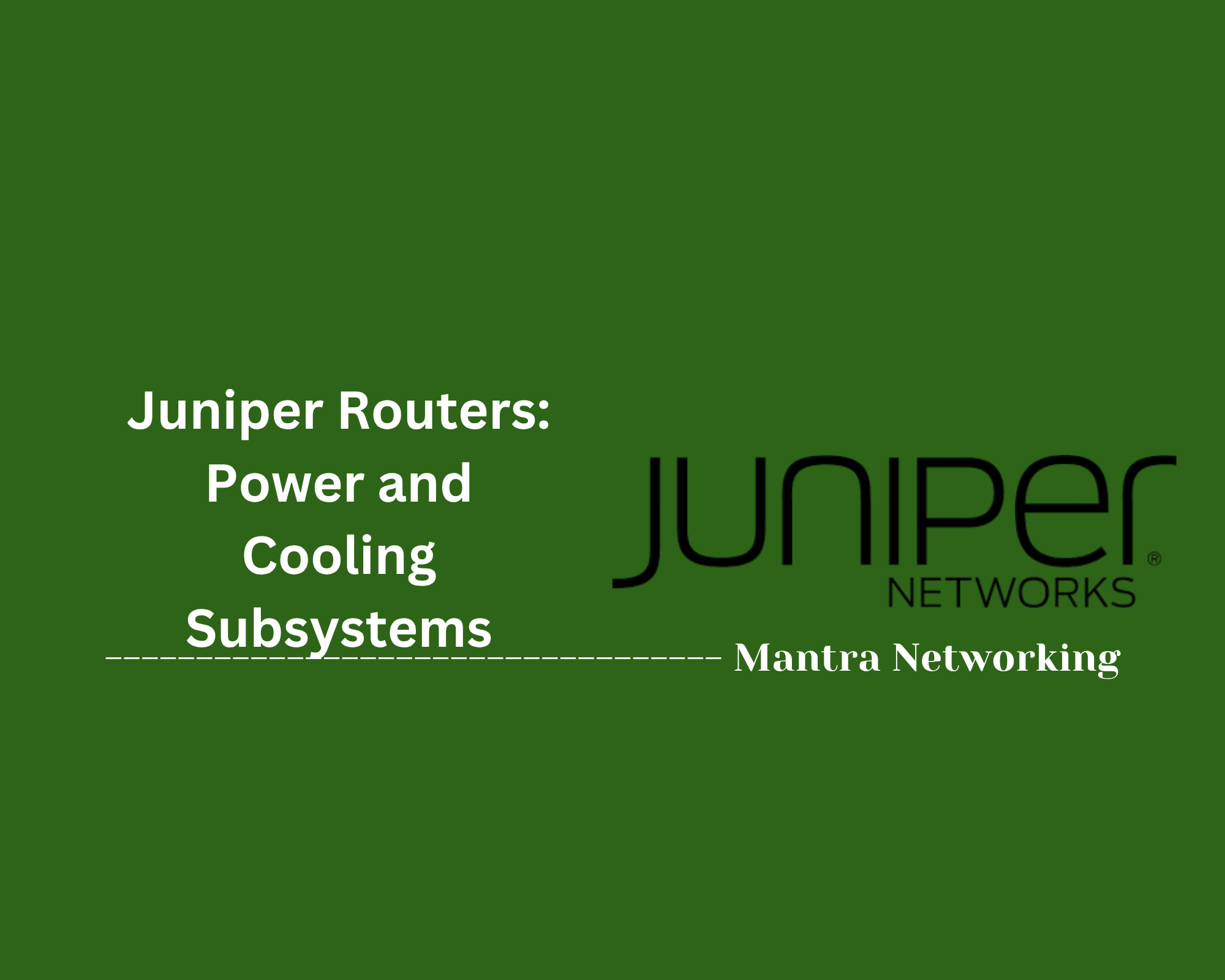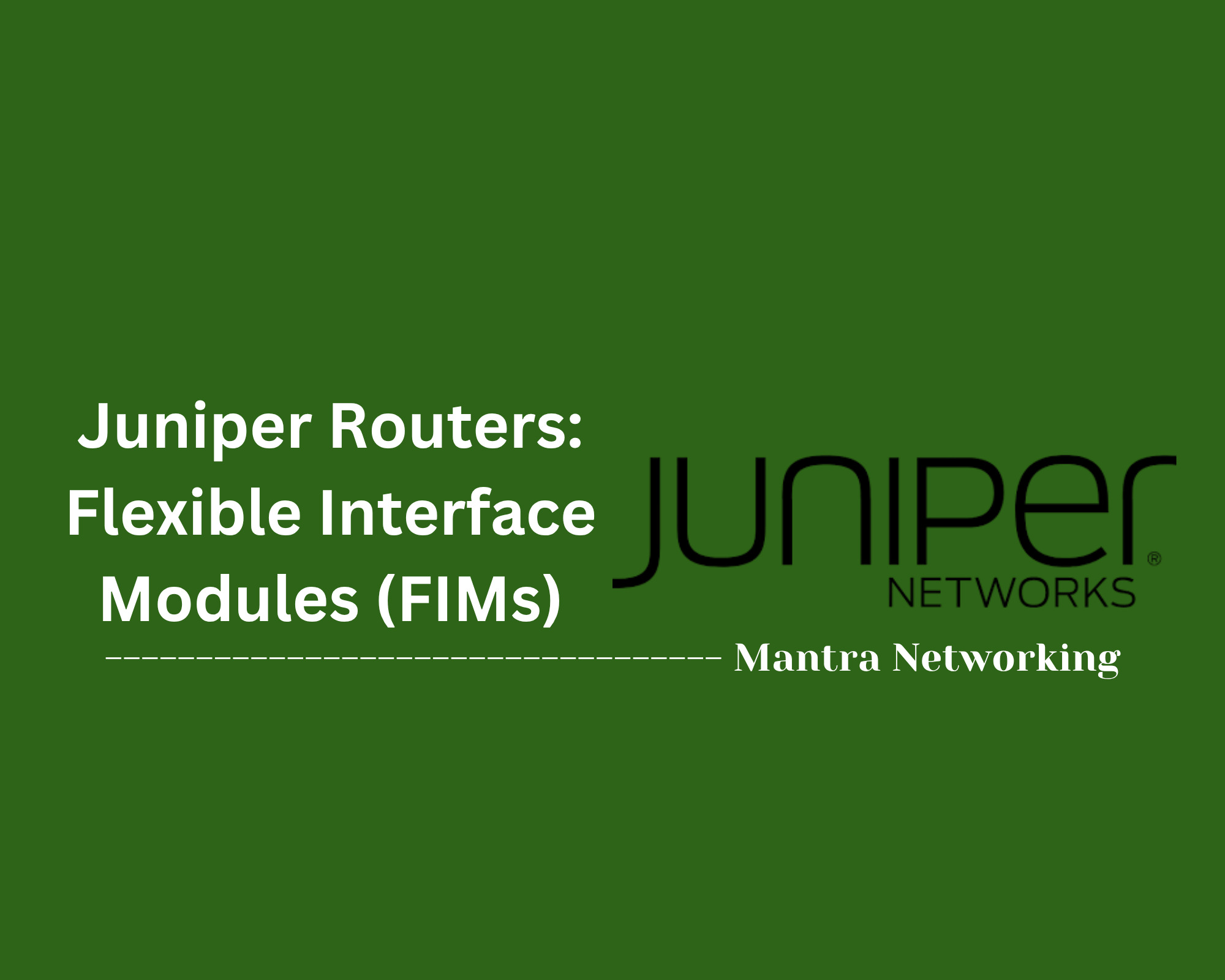Table of Contents
- Overview
- Key Components of Juniper Switching Fabric
- Fabric Architecture Types
- Fabric Performance Characteristics
- Juniper Switching Fabric in Practice
- Operational Considerations
- Conclusion
Overview: Juniper Switches – Switching Fabric
What is the Switching Fabric?
The switching fabric is the high-speed internal network that connects all the major components of a Juniper switch, such as line cards, control modules, and service modules. Think of it as the “central nervous system” of the switch, enabling data packets to travel rapidly across different parts of the device without bottlenecks. The design and capabilities of the switching fabric determine how much traffic the switch can handle and how efficiently it processes data internally.
Why is the Switching Fabric Important?
- Performance:
The speed and efficiency of the switching fabric directly impact the switch’s total throughput, or how much data it can move at once. A robust fabric ensures non-blocking performance, allowing every port to run at full capacity even under heavy loads. - Resiliency:
High-end switching fabrics provide redundancy—if one pathway or module fails, others can take over to prevent downtime. This is essential for mission-critical networks where continuous uptime is required. - Scalability:
Modular switching fabrics found in enterprise and data center switches can be expanded by adding more modules, supporting growing network demands without replacing the entire switch. - Advanced Features:
The switching fabric enables advanced capabilities like multi-chassis aggregation, spine-leaf topologies in data centers, and seamless integration of features like automation and network virtualization.
How Does It Work?
- Internal Pathways:
Inside a Juniper switch, the switching fabric consists of high-speed electrical or optical connections (on circuit boards known as backplanes or midplanes) that link all major modules together. - Packet Processing:
When a data packet arrives, specialized hardware chips called ASICs, or Packet Forwarding Engines (PFEs), handle the decision-making and direct the packet through the switching fabric to the correct destination port at very high speeds. - Redundant Architecture:
Many Juniper switches are designed with redundant fabric modules, meaning if one path or module fails, traffic automatically reroutes through backup paths or modules, ensuring no interruption. - Fabric Types:
Juniper implements several fabric designs, such as centralized (a single fabric module), distributed (multiple fabrics working in parallel), and Clos (spine-leaf) architecture for extremely large, high-performance networks.
Understanding the switching fabric is essential for anyone deploying or managing Juniper networks, as it forms the backbone of reliable, high-performance connectivity within modern organizations.
Key Components of Juniper Switching Fabric
Juniper’s switching fabric consists of several critical components that work together to ensure high-speed, reliable packet forwarding within the switch chassis:
- Fabric Modules: Dedicated hardware modules that serve as the backbone for internal data transfer. They interconnect line cards and control cards, enabling high-bandwidth communication across the switch.
- Backplane / Midplane: The physical circuit board inside the chassis that provides the electrical pathways for data signals between cards. It forms the base layer connecting fabric modules, line cards, and control cards.
- Packet Forwarding Engines (PFEs): Custom ASICs embedded in line cards and fabric modules that handle packet processing and forwarding at hardware speeds. PFEs interface with the fabric to send and receive data across the switch.
- Control Plane: Responsible for managing routing protocols, switch configuration, and fabric health, the control plane communicates with PFEs and fabric modules to maintain optimal operation.
- Redundant Fabric Paths: Many Juniper chassis switches are designed with multiple fabric modules and redundant pathways to provide high availability and avoid network disruption during hardware failures.
Fabric Architecture Types
Juniper switches support several key fabric architectures designed to optimize data transfer, scale, and resiliency across different deployment needs:
-
Centralized Fabric Architecture:
A single central fabric module or backplane manages all traffic between line cards and modules. This architecture is common in smaller or traditional chassis-based switches, providing straightforward management and consistent performance for environments with limited scaling needs. -
Distributed Fabric Architecture:
Multiple fabric modules are distributed across the switch, interconnecting line cards for parallel data transfers. Distributed fabric designs increase bandwidth and provide redundancy, making them suitable for modular, high-capacity enterprise and data center switches. -
Clos (Spine-Leaf) Architecture:
Based on a multi-stage Clos topology, this design uses a layer of leaf switches (access layer) and a layer of spine switches (core interconnect) to form a non-blocking, high-performance fabric. The Clos or spine-leaf architecture delivers exceptional scalability and resiliency, making it a popular choice for modern data centers and cloud environments. It minimizes latency and enables any-to-any device connectivity within the fabric[1][6][7]. -
Virtual Chassis and QFabric:
Juniper’s proprietary technologies enable multiple switches to operate as a single logical device. Virtual Chassis is optimized for campus and small data center networks, while QFabric provides a flat, ultra-low latency fabric by collapsing multiple network layers into a single-tier structure suitable for large-scale environments[5][6][8].
| Architecture Type | Main Features | Use Cases |
|---|---|---|
| Centralized Fabric | Single central fabric, simple management, stable performance | Small-to-midsize core/distribution switches |
| Distributed Fabric | Multiple fabrics, high bandwidth, redundancy | Enterprise and modular chassis switches |
| Clos (Spine-Leaf) | Multi-stage topology, scalable, low latency, high resiliency | Data centers, cloud, high-density networks |
| Virtual Chassis / QFabric | Multiple switches act as one; flat design, low latency | Campus, small/large data centers, simplified management |
Fabric Performance Characteristics
Juniper’s switching fabric delivers high performance and resiliency to efficiently handle demanding, large-scale network environments. The following characteristics define the core performance aspects of Juniper’s switching fabrics:
- Throughput: Modern Juniper fabrics offer multi-terabit per second capacity. For example, platforms like the MX10004 support total fabric throughput scaling up to 38.4 Tbps with all fabric modules installed, while the QFX Series can deliver up to 25.6 Tbps of bidirectional, line-rate switching to meet the needs of dense data center fabrics[6][15].
- Redundancy: High availability is ensured through N+1 or 1+1 redundant fabric module designs. This enables service continuity even if a fabric module fails, as the system reroutes traffic across additional, hot-standby paths[6][7].
- Latency: Direct ASIC-to-ASIC connections and parallel data paths minimize packet forwarding delays. Juniper designs deliver consistently low-latency switching even under heavy loads, especially in architectures like Clos/spine-leaf fabrics[2][7].
- Scalability: The fabric architecture is modular, allowing bandwidth scaling by adding more fabric modules or planes. In some core platforms, multi-chassis fabric extensions provide further scalability for large, distributed environments[7][13].
- Resiliency and Load Balancing: Active-active parallel switch planes and dynamic load balancing ensure non-blocking performance and graceful degradation, maintaining service even during hardware component failures[9][13].
- Hot-Swappable Fabric Modules: Key fabric components are hot-removable and hot-insertable, supporting in-service upgrades and maintenance with minimal operational impact[6].
| Characteristic | Description | Example/Notes |
|---|---|---|
| Throughput | Multi-terabit per second, non-blocking switching | MX10004: up to 38.4 Tbps; QFX5220: up to 25.6 Tbps[6][15] |
| Redundancy | N+1, 1+1, fabric and path redundancy | Hot standby and active-active planes[7][13] |
| Latency | Low and consistent, ASIC-optimized forwarding | Crucial for data centers and carrier backbones[2][7] |
| Scalability | Modular/expandable bandwidth | Add more fabric modules or extend with multi-chassis[7][13] |
| Resiliency | Automatic failover and load balancing | No single point of failure, in-service upgrades[9][13] |
| Operational Flexibility | Hot-swap modules, in-service maintenance | Supports upgrades/repairs with minimal downtime[6] |
Juniper Switching Fabric in Practice
Juniper switching fabrics are implemented across a range of platforms to deliver scalable, resilient, and high-performance networking for various deployment scenarios. Here’s how Juniper’s fabric technologies are applied in practical network environments:
-
EX Series Switches:
These switches are widely used in enterprise branch, campus, and data center networks. The EX Series supports cloud-ready features, automation, and integrated fabrics—such as Virtual Chassis and Virtual Chassis Fabric modes—enabling multiple switches to operate as a single logical device for simplified management and high availability. Platforms like EX8200 use separate, replaceable fabric modules, providing hot-swap capability for minimal downtime and improved resilience[10][6][18]. -
QFX Series Switches:
Designed for high-performance data centers, QFX switches provide the building blocks for fabric architectures such as spine-leaf, QFabric, and Junos Fusion. These switches offer wire-speed switching (up to 25.6 Tbps bidirectional in flagship models), low latency, and advanced automation for large-scale, reliable fabrics. QFX platforms support hot-swappable fabric cards for maximum uptime and can operate as standalone, fabric nodes, or in Virtual Chassis/Fabric roles[7][11][14][15][19]. -
Trio and Express ASICs:
Key to Juniper’s performance and efficiency, these proprietary ASICs optimize packet forwarding and switching fabric efficiency. The Trio ASIC (e.g., in MX routers) is focused on scale and legal forwarding, while the Express family powers high-bandwidth switching and core routing functions, supporting cell-based fabric designs, advanced resiliency, and energy efficiency for demanding environments[8][12][16]. -
Campus and Data Center Fabrics:
In large campus or data center deployments, Juniper employs EVPN-VXLAN for layer 2/3 fabric connectivity and centralized management via the Apstra platform. This framework enables seamless scaling, network segmentation, and simplified deployment with automated Day 0/Day 2 operations[2][5]. -
Operational Agility:
Across all platforms, Juniper’s support for hot-swappable fabric modules, in-service software upgrades, and closed-loop automation ensures minimal disruption and simplified maintenance in production networks[6][7][11].
| Platform/Series | Key Fabric Features | Deployment Use Cases |
|---|---|---|
| EX Series | Virtual Chassis/Fabric, hot-swappable modules, unified management | Branch, campus, cloud-managed networks |
| QFX Series | Non-blocking multi-Tbps switching, modular fabric cards, support for spine-leaf, QFabric, EVPN-VXLAN | Data center underlay/overlay, large-scale fabrics |
| MX Series | Trio ASICs, modular fabric, high-resiliency design | Carrier, WAN edge, cloud and core routing |
| Campus/DC Fabrics | EVPN-VXLAN, Apstra intent-based automation, scalable Clos architecture | Large campus and cloud data centers |
| Express ASIC platforms | Cell-based switching, low latency, high energy efficiency | Core routing, dense data center switching |
Operational Considerations
Successful management of Juniper’s switching fabric relies on robust operational practices, proper maintenance, proactive monitoring, and streamlined upgrade processes. The following key considerations help maintain fabric health, resilience, and performance:
-
Proactive Monitoring:
Leverage Junos Telemetry Interface (JTI) and streaming telemetry tools to monitor switch health, buffer utilization, link usage, microbursts, and latency in real time. Advanced telemetry enables faster troubleshooting, root-cause analysis, and capacity planning by providing detailed, high-frequency performance metrics[6][7][19]. -
Redundancy Verification:
Regularly check that all redundant fabric modules and paths are operational and that failover mechanisms are tested. Ensure monitoring for component alarms (such as failed fabric boards, power supplies, or fan trays) to prevent service disruption[2][6]. -
Hot-Swappable Hardware and Maintenance:
Take advantage of hot-removable and hot-insertable fabric modules and fans for servicing or upgrading hardware with minimal downtime. Follow antistatic handling and proper storage protocols for removed boards (e.g., use protective covers and antistatic mats or bags)[6]. -
Software Upgrades:
Use features like Nonstop Software Upgrade (NSSU) on supported platforms to update Junos OS with near-zero control plane disruption. Leverage zero-touch provisioning and configuration synchronization in environments using Virtual Chassis Fabric for streamlined upgrades and migrations[2]. -
Configuration Consistency and Automated Backups:
Ensure configurations across fabric nodes are kept synchronized as part of regular operations. Utilize automation frameworks and regular configuration/image backups to support fast recovery[2][8]. -
Periodic Preventive Checks:
Perform routine environmental and system checks, such as monitoring chassis alarms, temperature, power, storage usage, and reviewing system logs for anomalies. Planned failovers and operational tests help catch latent issues before production impact[9].
| Operational Task | Purpose | Tools/Methods |
|---|---|---|
| Telemetry & Real-Time Monitoring | Detect and resolve health issues quickly | JTI, Junos telemetry, Mist AI, third-party monitoring |
| Hot-Swap Maintenance | Minimize downtime during repairs/upgrades | Follow handling procedures, use redundant components |
| Software Upgrades (NSSU) | Upgrade OS with minimal traffic disruption | NSSU, configuration/image sync, zero-touch updates |
| Redundancy Checks | Ensure high availability and quick recovery | Regular failover tests, chassis alarm monitoring |
| Configuration Consistency | Speed up recovery, enable automation | Automated backups, config templates, Mist cloud |
| Preventive Maintenance | Avoid unplanned outages, detect potential failures | Periodic environment/system checks, log review |
Conclusion
Key operational practices—including proactive monitoring, seamless software upgrades, and redundancy testing—help ensure ongoing fabric health and optimal performance. By understanding these best practices and underlying technologies, network professionals can confidently build and maintain reliable, high-performance Juniper networks.
Thanks for joining us on this deep dive into Juniper's switching fabric. If you have questions or want to learn more about Juniper’s networking solutions, feel free to reach out or leave a comment. Happy networking!



